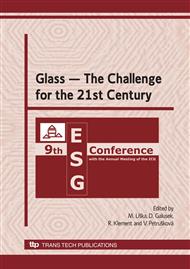p.375
p.381
p.387
p.391
p.395
p.399
p.405
p.413
p.419
Evolution of Absorption Spectra in the Process of Nucleation in Photo-Thermo-Refractive Glass
Abstract:
Photo-thermo-refractive (PTR) glass belongs to a class of photosensitive multicomponent silicate glasses which demonstrate photo-thermo-induced precipitation of a crystalline phase. Photo-induced crystallization of sodium fluoride results in refractive index variations in exposed areas of PTR glass which was successfully applied for phase hologram recording. However, even if this glass is widely used for advanced optical applications such as the stabilization of laser diodes or spectral beam combining, the detailed mechanism of its photosensitivity is not well known. We present in this paper an analysis of the evolution of the absorption spectra of UVexposed PTR glass at the early stages of the thermal treatment (nucleation). Absorption spectra were measured on samples nucleated at constant temperature for different periods. Analysis of the structure of these spectra shows that the optimum of the nucleation process is associated with the appearance of a new absorption band in visible range that disappears when the crystal growth process starts. Analogous study was performed during the nucleation process. High temperature spectroscopic measurements were performed during the thermal treatment. It was found that absorption spectra evolve with a change of temperature, i.e. the band structure of these spectra is different whether or not the temperature is decreased below a temperature of ~400°C. We associate this process with the change of phase of the silver bromide nuclei (liquid/solid) that appears during the cooling or heating processes.
Info:
Periodical:
Pages:
395-398
Citation:
Online since:
April 2008
Authors:
Price:
Сopyright:
© 2008 Trans Tech Publications Ltd. All Rights Reserved
Share:
Citation:


